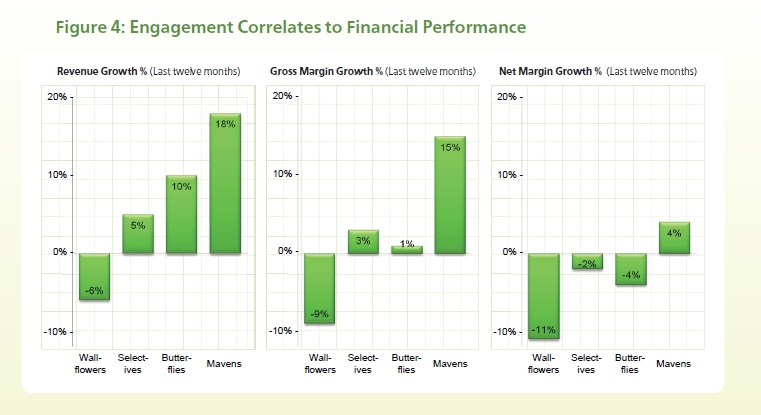The one question all marketers will surely be asked when trying to implement a social media plan for their companies is “Will this make us money? ” According Charlene Li the answer is yes, in her 2009 study The World’s Most Valuable Brands. Who’s most engaged? Li describes there is a direct correlation between financial performance and deep social media engagement.
In the study Li and her group study the top 100 global brands and attempt to quantify how deeply engaged they are in social media and then see if there is a correlation with financial performance. To measure engagement two separate criteria are used; number of social media channels and depth of involvement in those channels.
In the study, companies fell into four categories of social media engagement
- Mavens – brands that have made social media a core part of their go-to-market strategies and are very active in many channels; usually driven by dedicated teams assisted by company-wide awareness and participation.
- Butterflies — brands that recognize the need to be in many channels but have only met with real success in a subset of their activities; these companies are usually spread a bit too thin.
- Selectives – brands that focus on just a few channels and excel in those; these efforts are usually initiated by an internal evangelist.
- Wallflowers — brands present in only a few channels and very lightly in those; these brands are sitting on the sidelines and are wary of the risks. They are still trying to figure out the best next steps and investments in social media.
To measure financial performance the study used three metrics: Revenue Growth, Gross Margin Growth and Net Margin Growth, all data was from 2008. In each of the measures Mavens showed positive results, which is particularly impressive since 2008 is year where any positive financial result was a monumental achievement.
What is especially noticeable from the charts above is the stark contrast in results between the Mavens and Wallflowers; can it really be this simple to generate profits? Of course the answer is no. While Li believes there is a correlation between social media engagement and financial performance she is careful to state that they are not claiming a causal relationship but rather that there is a connection. How strong is the correlation? Well I’m no math geek and the study doesn’t give the correlation numbers anyways but I would assume there is a fair bit of noise in the numbers. Is it believable that it could be a predictor? I think yes and the qualitative part of the study may tell us why.
Li describes the best practices of four industry leaders, Starbucks(#1), Dell (#2), SAP (#9) and Toyota (#21) and while they operate in different industries and have different customer bases they all describe a common theme at the core of their social media plan which is that all employees must be engaged. All four companies made it a priority to involve all levels of their organization in an attempt top best interact with customers and to create brand engagement. The more prevalent this engagement is both in terms of channels and depth it makes sense that the companies’ overall performance should benefit.
To be honest I think if you took the social media part out of this study went back to the year 2000 or 1990 and measured companies who had high level of engagement within the organization and with customers and compared their financial results with the companies that didn’t, the results would be the same. I think what Li’s true contribution to marketers is that she details that social media isn’t some magic bullet to cure all your marketing and sales problems but rather an essential tool that requires complete organizational commitment to extract its full value and one that should be measured with the overall performance of the business.
